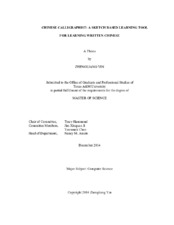| dc.description.abstract | Learning Chinese as a foreign language is becoming more and more popular in western countries, however it is also very hard to be proficient, especially in writing. The involvement of the teachers in the process of learning Chinese writing is extremely necessary because they can give timely critiques and feedbacks as well as correct the students’ bad writing habits. However, it is inadequate and inefficient of the large class capacity therefore it is urgent and necessary to design a computer-based system to help students in practice Chinese writing, correct their bad writing habits early, and give feedback personally.
The current written Chinese learning tools such as online tutorials emphasize writing rules including stroke order, but it could not provide practicing sessions and feedback. Hashigo, a novel CALL (Computer Assisted Language Learning) system, introduced the concept of sketch-based learning, but it’s low level recognizer is not proper for Chinese character domain.
Therefore in order to help western students learn Chinese with better understanding, we adopted LADDER description language, machine learning techniques, and sketch recognition algorithms to improve handwritten Chinese stroke recognition rate.
With our multilayer perceptron recognizer, it improved Chinese stroke recognition accuracy by 15.7% than the average of the four basic recognizer. In feature selection study we found that the most important features were “the aspect of the bounding box”, and the “density metrics”, and “curviness”. We chose 8 most important features after the recursive selecting stabilized. We discovered that in most situations, feature recognition is more important than template recognition. Since the writing technique is emphasized while they are taught, only 2 templates is enough. It worked as well as 20 templates, which improved recognition speed dramatically.
In conclusion, in this thesis our contribution is that we (1) proposed a natural way to describe Chinese characters; (2) implemented a hierarchical Chinese character recognizer combining LADDER with the multilayer perceptron low level recognizer; (3) analyzed the performance of different recognition schemes; (4) designed a sketch-based Chinese writing learning tool, Chinese Calligraphist; and (5) find the best feature combination to recognize Chinese strokes while improving the recognition accuracy. | en |


